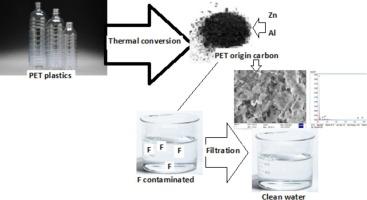Preparation of low-cost metal-loaded adsorbent using post-consumer waste plastics: Experimental and modelling studies
Q1 Environmental Science
Environmental Nanotechnology, Monitoring and Management
Pub Date : 2024-09-18
DOI:10.1016/j.enmm.2024.101009
引用次数: 0
Abstract
Fluoride contamination in drinking water is a world-wide problem which causes dangerous irreversible diseases called fluorosis. The present study highlighted the efficacy of metals (Al and Zn) impregnated thermally degraded products of polyethylene terephthalate (PET) towards the removal of fluoride from the solution. Synthesized metal impregnated carbonaceous materials was characterised by pHzpc, proximate analysis, SEM, EDX and FTIR studies. A batch adsorption study with operating variables such as initial concentration, pH, adsorbent dose, contact time, temperature and agitation speed were undertaken. Then an optimization study was performed through Response Surface Methodology (RSM). The results revealed that the adsorption isotherm and kinetics followed Langmuir Isotherm model (R2 = 0.968) and pseudo-second order kinetics (R2 = 0.995), respectively with adsorption capacity 6.793 mg/g. The thermodynamics of fluoride adsorption reveal that the adsorption was spontaneous and endothermic in nature. The RSM results demonstrated the optimization of operating parameters such as initial concentration (9.95 mg/L), adsorbent dose (0.01 g/50 mL), contact time (11.42 min) and temperature (331 K). The result from perturbation plot indicate that the most influential parameters are initial concentration followed by temperature and adsorbent dose and the least influential parameter is contact time. Finally, it can be concluded that waste PET plastics could be a valuable adsorbent for decontamination of pollutants from aqueous medium.

利用消费后废塑料制备低成本金属吸附剂:实验和模型研究
饮用水中的氟污染是一个世界性的问题,它会导致不可逆转的危险疾病--氟中毒。本研究强调了浸渍聚对苯二甲酸乙二酯(PET)热降解产物的金属(铝和锌)从溶液中去除氟化物的功效。通过 pHzpc、近似分析、扫描电镜、EDX 和傅立叶变换红外光谱研究对合成的金属浸渍碳质材料进行了表征。对初始浓度、pH 值、吸附剂剂量、接触时间、温度和搅拌速度等操作变量进行了批量吸附研究。然后通过响应面法(RSM)进行了优化研究。结果表明,吸附等温线和动力学分别遵循 Langmuir 等温线模型(R2 = 0.968)和假二阶动力学(R2 = 0.995),吸附容量为 6.793 mg/g。氟化物吸附热力学表明,吸附是自发的,具有内热性质。RSM 结果表明,对初始浓度(9.95 毫克/升)、吸附剂剂量(0.01 克/50 毫升)、接触时间(11.42 分钟)和温度(331 K)等操作参数进行了优化。扰动图结果表明,影响最大的参数是初始浓度,其次是温度和吸附剂剂量,影响最小的参数是接触时间。最后,可以得出结论:废 PET 塑料可以作为一种有价值的吸附剂来净化水介质中的污染物。
本文章由计算机程序翻译,如有差异,请以英文原文为准。
求助全文
约1分钟内获得全文
求助全文
来源期刊

Environmental Nanotechnology, Monitoring and Management
Environmental Science-Water Science and Technology
CiteScore
13.00
自引率
0.00%
发文量
132
审稿时长
48 days
期刊介绍:
Environmental Nanotechnology, Monitoring and Management is a journal devoted to the publication of peer reviewed original research on environmental nanotechnologies, monitoring studies and management for water, soil , waste and human health samples. Critical review articles, short communications and scientific policy briefs are also welcome. The journal will include all environmental matrices except air. Nanomaterials were suggested as efficient cost-effective and environmental friendly alternative to existing treatment materials, from the standpoints of both resource conservation and environmental remediation. The journal aims to receive papers in the field of nanotechnology covering; Developments of new nanosorbents for: •Groundwater, drinking water and wastewater treatment •Remediation of contaminated sites •Assessment of novel nanotechnologies including sustainability and life cycle implications Monitoring and Management papers should cover the fields of: •Novel analytical methods applied to environmental and health samples •Fate and transport of pollutants in the environment •Case studies covering environmental monitoring and public health •Water and soil prevention and legislation •Industrial and hazardous waste- legislation, characterisation, management practices, minimization, treatment and disposal •Environmental management and remediation
 求助内容:
求助内容: 应助结果提醒方式:
应助结果提醒方式:


